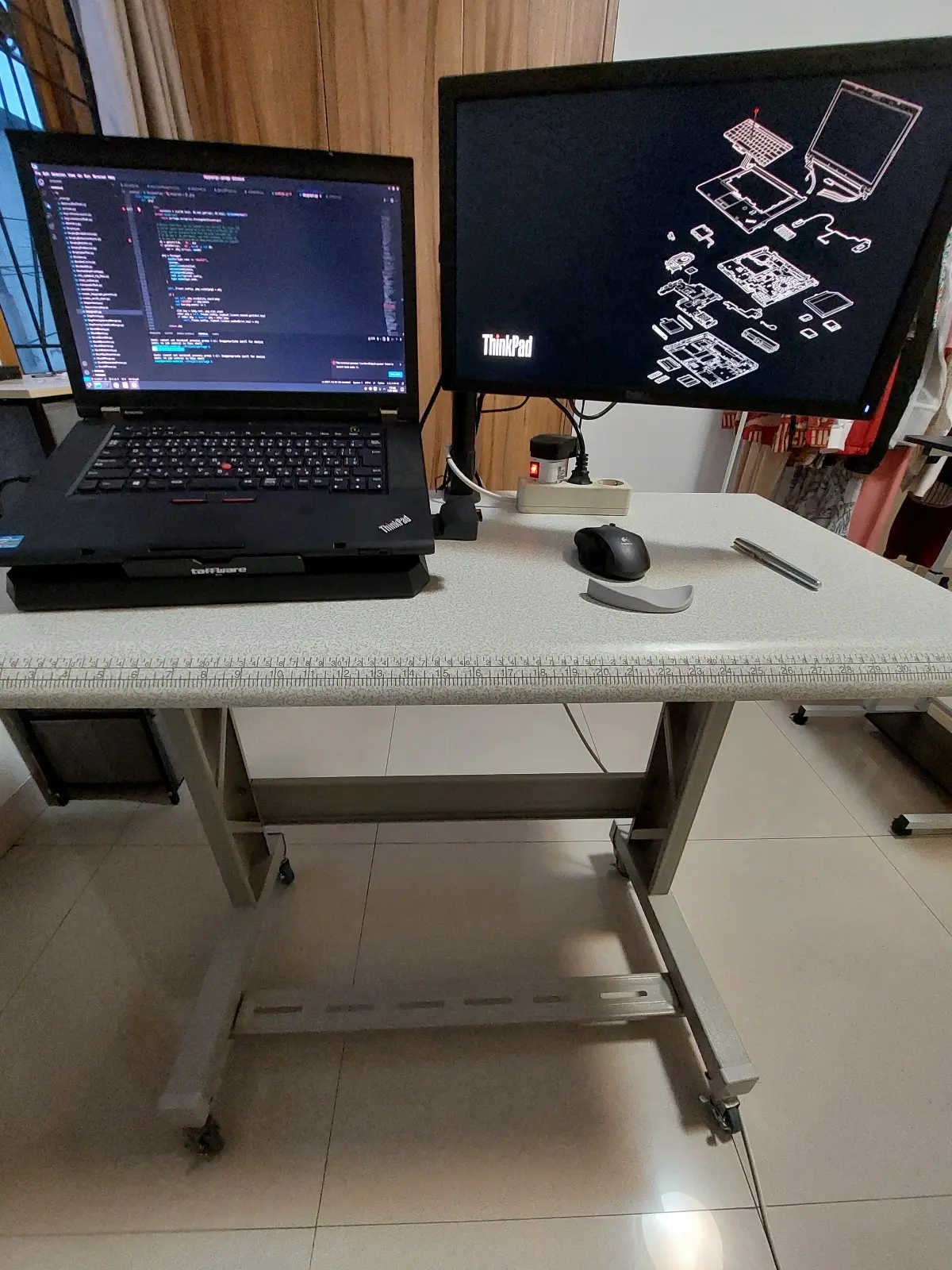I literally rocked an old laptop for years like this, lol.
And some models work without any battery at all, my dell XPS circa 2008. I am still amazed at that. It still runs too, I just retired it from server duty a few years ago once I got a dedicated server.
how about…

…some wheels
I used that when there were some games unsupported on my XP PC, but working on a shittier but light-weight W7 notebook. That was weird. I was worried it’d melt through my table.
I feel so called out
I have four laptops and two desktops… More or less.
One laptop is an antique, I might break it out to play music while I cook, but it’s kind of useless for anything else at this point. One is a tablet, complete with a digital pen. I only bust it out to sign digital documents. My main personal laptop is an 11th gen framework. The last laptop in my collection is my work laptop. Technically not mine, but I’ll throw it in anyways.
My work laptop 99% of the time is sitting on my desk, connected to a dock which is plugged into a KVM switch.
My main desktop is also plugged into the same KVM.
My laptop rarely moves. I like that about it.
My framework is almost never on any kind of dock, or connected to any external display. I mainly use it on my lap around the house
The other desktop is plugged into my TV to play video games.
I mean, I have other computers, but those are the main ones.
I mean I don’t want to talk negative about your hobbies, but you have a pc hoarding issue.
I have one for myself, but not that bad yet.
Back in the early 1990s, I would go to Goodwill and pick up whatever ancient computers and related machines that people had discarded there. I amassed quite a collection. But at some point, when you’re hauling a useless VT240 terminal home and you realize it’s just going to sit in the garage, you conclude that you’re really not doing a smart thing.
I would say the person above should keep the ones they’re talking about and get rid of the “other computers” unless there’s a good reason to keep them.
Useless? That’s a necessity for using your router console port!
I have to imagine there’s an option that weighs less than a large concrete block.
You have no idea.
I mean, you still can use it on the go if you need to.
I want to add an extra panel where the laptop gets connected to AC power as well, and powers up like Popeye eating spinach.
I love this animation style so much haha
That’s me!! Whenever I have that sucker at home from work the first thing I do is using my own peripherals. The difference is Day and Night!
When I need to do stupid tasks like timesheets and emails I unplug. The lack of screen space means I don’t get distracted.
When I need to do hard work I dock my system and use my dual 4Ks to maximize visual bandwidth.
I did this too long and now my battery barely holds a charge
This is simply because of how batteries work. We’re focusing on lithium ion batteries, the most common in computing at our current point in time, and these are simplifications and not electrical engineering down to the exactest detail.
They can only hold the max charge when brand new. As they are used (charged and discharged), literal physical wear is happening within the battery (really, series of battery cells, it is not one chunk that fails at once). The capacity for the ions to “stay” on the desired side of the anode-cathode pair diminishes over time.
This is why batteries are advertised as maintaining x amount (usually 80%) after x cycles (usually 500) and why a device having a good Battery Management System (BMS) can be as important as how many mAH units a battery is rated as having.
As to why a plugged in battery suffers the same fate? Physics is cruel. A charge cycle is just defined as using an amount equal to 100% of your battery. Nothing says it has to be all at once.
A plugged-in lithium-ion battery still undergoes wear because it experiences minor discharges and recharges, contributing to charge cycles. Heat from constant charging and chemical aging also degrade the battery over time, leading to shorter battery life when eventually used unplugged.
I went from desktop to 100% laptop over several years; now I’m back on a desktop - using one of those Ryzen 7 mini-PCs - and a 36-key GMK Cherry MX split keyboard that, stacked, is barely larger than the computer. I’m seriously considering getting a small Thunderbolt dock and just carrying that with me between work and wherever. The only annoying bit is the computer I have isn’t powered over the USB-C port, which means also carrying a power brick, and that’s the straw that keeps me synching data between my computer and laptop.
I could move everything to a bootable USB device, but even over USB-C that’d be orders of magnitude slower than NVMe or SATA.
The laptop is only two years older than the desktop (and maybe less than that since I didn’t buy the most current model), cost nearly 3x the PC, and is utterly blown out of the water by the specs on the micro(? 12.5 x 12.5 x 4 cm) PC. Yeah, the laptop has keyboard, pointer, battery, and monitor; that impacts size and cost, but still. I could almost use my PC in a coffee shop, if it weren’t for the power brick and the need to do something about a monitor.
I have a foldable phone. Maybe by the time that display technology gets scaled up (and onto the market) there’ll be a micro PC that’s powered over USB-C and I can put together a small, laptop-sized case with everything I need.
The Frameworks are looking good, though, now that they’re selling AMD models. I’ll have to check in, in a year or so.
I can’t get over it.
You’re one neat backpack and a decent repurpose-able display tablet with a kickstand away from a dream nomad set up.
How big is this power brick that it features so strongly in the ‘cons’ column!?
It’s not, really: 10x5x2.5 cm, plus the wall plug; but it’s still there, and it’s irritating because they could easily have powered this thing over USBC. Hell, most of my flashlights have USBC charging ports. It’s an additional thing to carry, and another thing to have to plug in. Plus, not being USBC makes it far harder to run off a battery pack.
You’re right about the rest of it, though.
You could get an nvme to USBC thing, that should be pretty fast
TB4 is like 5000MB/s if the mini PC has that. Plenty fast for a lot of applications. It’ll cap an NVME but it’s good enough to run off of.
Is it? I haven’t tried, but there’s a pretty big gulf between an NVMe interface max bandwidth and TB4’s. I mean, TB4 is pretty amazing (40Gbps), but NVMe m.2 is 128Gbps; Sabrent makes an m.2 SSD with 104kGbps read speeds; heck, Crucial has a $114 2TB m.2 SSD they claim gets 40k/33.6k R/W. And this assumes that whatever computer you get access to has a TB4 port, and not just USBC 3.0, which tops out at 5Gbps.
But this all reminds me that I need to get a bigger NVMe stick and move everything off the SCSI SSD.
Depends on exactly what you need. For a lot of day to day tasks, especially if you’re not moving around large amounts of data, TB4 speeds are probably fine.
I wouldn’t do it with USB 3.0, but 3.2 gen 2 could theoretically work depending on your workload and use case.
My usage barely benefits past 3.2 gen 2 because my disk is never my bottleneck. It’s either network or processor. It’s one of those things where everyone has to look at their own usage and decide.
This is… fair. But, while I don’t often move large amounts of data, consider: this thread started with me speculating about using a bootable USB drive instead of hauling computer equipment around. So we have to consider that (a) booting will be frequent - more frequent than a desktop or even laptop, maybe twice daily if I’m moving between work and home. That’s going to be relatively slow. Then starting up whatever programs: the desktop, apps - god forbid I need to use Eclipse or another monster programs.
I guess I might be able to set it up for hibernate, but since that stores machine state including devices and network state which are going to vary between computers, I’m guessing that’s not going to work reliably if at all.
USB 3.x and TB4 put this more in the range of possibility, but it still sounds slow.
Yeah, I may have gone a bit far afield to try to point out that it can be done. It’s not going to be for everyone, and maybe it would be too slow for you.
It was fun to think about, and I enjoyed the friendly conversation.
Don’t get me wrong: the idea is super appealing, and the technology has gotten good enough it’s practical - i absolutely agree about that. I was only saying that there’d be a noticeable difference in performance of you’re used to M.2 NVMe.
I think a bigger concern is trusting other people’s hardware. It’s getting increasingly fraught, with key loggers and such; I’m not sure how much I’d trust my (digital) life to a random computer - and then there’s the issue of secure boot, and needing computers that have either unprotected BIOS menus or which are already configured to boot first from USB (which is IME an increasingly rare default configuration).
ergonomics. portable screens need to be at eye level, keyboards need to be nearer, pointing devices are overdue for revolution on portables.
Also the shittier hardware for more money and noise/heat of a laptop. I tried using a high end laptop for a couple of years. Now I’m much happier after selling it and replacing it with a PC. 8th gen Intel laptops are dirt cheap and very capable for most tasks (as a secondary device) for when the portability is absolutely required.
pointing devices are overdue for revolution on portables.
Tilt control laptops when
id like to see eye tracking with dual caneras
I feel like that would be hard to implement alongside tilt controls
Gimbal
I’ve done this before building a dssktop PC. Probably not a bad way to start if you’re planning to have a desktop anyway, but not have enough money to buy all things needed to buy one.
I do you better. I have my macbook plugged into a 32", and a crappy 19" (which sits on top of my macbook), so I’m using two screens without using my macbook screen











